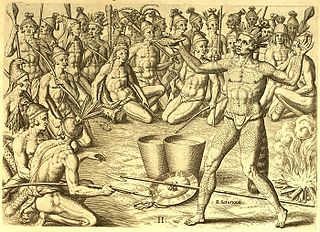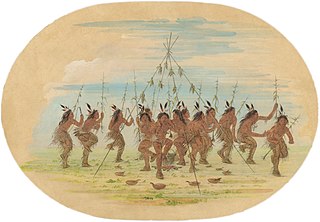Related Research Articles

A sweat lodge is a low profile hut, typically dome-shaped or oblong, and made with natural materials. The structure is the lodge, and the ceremony performed within the structure may be called by some cultures a purification ceremony or simply a sweat. Traditionally the structure is simple, constructed of saplings covered with blankets and sometimes animal skins. The sweat is a spiritual ceremony – it is for prayer and healing, and it is only to be led by Indigenous Elders who know the language, songs, traditions, and safety protocols of their culture's inherited tradition. Otherwise, the ceremony can be dangerous if performed improperly.

Arti or Arati is a Hindu ritual employed in worship, often part of a puja, in which light is ritually waved for the veneration of deities. Arti(s) also refers to the songs sung in praise of the deity, when the light is being offered. Sikhs also perform Aarti in the form of Aarti Kirtan which involves only devotional singing but Nihang Sikhs specifically perform Aarta which uses light as well.

Indigenous music of North America, which includes American Indian music or Native American music, is the music that is used, created or performed by Indigenous peoples of North America, including Native Americans in the United States and Aboriginal peoples in Canada, Indigenous peoples of Mexico, and other North American countries—especially traditional tribal music, such as Pueblo music and Inuit music. In addition to the traditional music of the Native American groups, there now exist pan-Indianism and intertribal genres as well as distinct Native American subgenres of popular music including: rock, blues, hip hop, classical, film music, and reggae, as well as unique popular styles like chicken scratch and New Mexico music.
Indigenous music of Canada encompasses a wide variety of musical genres created by Aboriginal Canadians. Before European settlers came to what is now Canada, the region was occupied by many First Nations, including the West Coast Salish and Haida, the centrally located Iroquois, Blackfoot and Huron, the Dene to the North, and the Innu and Mi'kmaq in the East and the Cree in the North. Each of the indigenous communities had their own unique musical traditions. Chanting – singing is widely popular and most use a variety of musical instruments.

Ceremonial drums are membranophones and idiophonic slit drums, which are played in a ritual context cult, religious or ceremonial social occasions by indigenous peoples around the world, often accompanied by singing or chanting.

The Sun Dance is a ceremony practiced by some Native Americans in the United States and Indigenous peoples in Canada, primarily those of the Plains cultures. It usually involves the community gathering together to pray for healing. Individuals make personal sacrifices on behalf of the community.
Neoshamanism refers to new forms of shamanism. It usually means shamanism practiced by Western people as a type of New Age spirituality, without a connection to traditional shamanic societies. It is sometimes also used for modern shamanic rituals and practices which, although they have some connection to the traditional societies in which they originated, have been adapted somehow to modern circumstances. This can include "shamanic" rituals performed as an exhibition, either on stage or for shamanic tourism, as well as modern derivations of traditional systems that incorporate new technology and worldviews.

Black drink is a name for several kinds of ritual beverages brewed by Native Americans in the Southeastern United States. Traditional ceremonial people of the Yuchi, Caddo, Chickasaw, Cherokee, Choctaw, Muscogee and some other Indigenous peoples of the Southeastern Woodlands used the black drink in purification ceremonies. It was occasionally known as white drink because of the association of the color white with peace leaders in some Native cultures in the Southeast.

Tiv are a Tivoid ethnic group. They constitute approximately 2.4% of Nigeria's total population, and number over 5 million individuals throughout Nigeria and Cameroon. The Tiv language is spoken by about 5 million people in Nigeria with a few speakers in Cameroon. Most of the language's Nigerian speakers are found in Benue, Taraba, Nasarawa, Plateau, Cross rivers, Adamawa, Kaduna, and Abuja States. The language is a branch of Benue–Congo and ultimately of the Niger–Congo phylum. In pre-colonial times, the Fulani ethnic group referred to the Tiv as "Munchi", a term not accepted by Tiv people. They depend on agricultural produce for commerce and sustenance.

African dance refers to the various dance styles of sub-Saharan Africa. These dances are closely connected with the traditional rhythms and music traditions of the region. Music and dancing is an integral part of many traditional African societies. Songs and dances facilitate teaching and promoting social values, celebrating special events and major life milestones, performing oral history and other recitations, and spiritual experiences. African dance utilizes the concepts of polyrhythm and total body articulation. African dances are a collective activity performed in large groups, with significant interaction between dancers and onlookers in the majority of styles.

The stomp dance is performed by various Eastern Woodland tribes and Native American communities in the United States, including the Muscogee, Yuchi, Cherokee, Chickasaw, Choctaw, Delaware, Miami, Caddo, Tuscarora, Ottawa, Quapaw, Peoria, Shawnee, Seminole, Natchez, and Seneca-Cayuga tribes. Stomp dance communities are active in North Carolina, Oklahoma, Alabama, Mississippi, and Florida.

The Green Corn Ceremony (Busk) is an annual ceremony practiced among various Native American peoples associated with the beginning of the yearly corn harvest. Busk is a term given to the ceremony by white traders, the word being a corruption of the Creek word puskita (pusketv) for "a fast". These ceremonies have been documented ethnographically throughout the North American Eastern Woodlands and Southeastern tribes. Historically, it involved a first fruits rite in which the community would sacrifice the first of the green corn to ensure the rest of the crop would be successful. These Green Corn festivals were practiced widely throughout southern North America by many tribes evidenced in the Mississippian people and throughout the Mississippian Ideological Interaction Sphere. Green Corn festivals are still held today by many different Southeastern Woodland tribes. The Green Corn Ceremony typically occurs in late July–August, determined locally by the ripening of the corn crops. The ceremony is marked with dancing, feasting, fasting and religious observations.

Smudging, or other rites involving the burning of sacred herbs or resins, is a ceremony practiced by some Indigenous peoples of the Americas. While it bears some resemblance to other ceremonies and rituals involving smoke from other world cultures, notably those that use smoke for spiritual cleansing or blessing, the purposes and particulars of the ceremonies, and the substances used, can vary widely among tribes, bands, and nations, and even more so among different world cultures. In traditional communities, Elders maintain the protocols around these ceremonies and provide culturally specific guidance. The smudging ceremony, by various names, has been appropriated by others outside of the Indigenous communities as part of New Age or commercial practices, which has also led to the over-harvesting of some of the plants used in ceremonies. The appropriation and the over-harvesting have both been protested by Indigenous people in the US and Canada.

Water drums are a category of membranophone characterized by the filling of the drum chamber with some amount of water to create a unique resonant sound. Water drums are used all over the world, but are found most prominently in a ceremonial as well as social role in the Indigenous music of North America, as well as in African music. The drums are most often made from a pot of clay, ceramic, wood or metal, with a small amount of liquid inside and topped with drum head consisting of a stretched membrane, usually of some type of animal hide.

Hosteen Klah was a Navajo artist and medicine man. He documented aspects of Navajo religion and related ceremonial practices. As a traditional nádleehi person, he was both a ceremonial singer and master weaver.

Native American religions are the spiritual practices of the Native Americans in the United States. Ceremonial ways can vary widely and are based on the differing histories and beliefs of individual nations, tribes and bands. Early European explorers describe individual Native American tribes and even small bands as each having their own religious practices. Theology may be monotheistic, polytheistic, henotheistic, animistic, shamanistic, pantheistic or any combination thereof, among others. Traditional beliefs are usually passed down in the forms of oral histories, stories, allegories, and principles.

The Native American Church (NAC), also known as Peyotism and Peyote Religion, is a Native American religion that teaches a combination of traditional Native American beliefs and Christianity, with sacramental use of the entheogen peyote. The religion originated in the Oklahoma Territory (1890–1907) in the late nineteenth century, after peyote was introduced to the southern Great Plains from Mexico. Today it is the most widespread indigenous religion among Native Americans in the United States, Canada, and Mexico, with an estimated 250,000 adherents as of the late twentieth century.

Two-spirit is a modern, pan-Indian umbrella term used by some Indigenous North Americans to describe Native people in their communities who fulfill a traditional third-gender ceremonial and social role in their cultures.

Ruthe Blalock Jones is a Delaware-Shawnee-Peoria painter and printmaker from Oklahoma.

Bear Dance is a Native American ceremonial dance that occurs in the spring. It is a ten-day event to strengthen social ties within the community, encourage courtship, and mark the end of puberty for girls.
References
- ↑ Green, Rayna; Fernandez, Melanie (1999). The British Museum Encyclopedia of Native North America. Indiana University Press. ISBN 978-0-253-21339-6.
- ↑ Callahan, Alice Anne (1993-03-01). The Osage Ceremonial Dance I'n-Lon-Schka. University of Oklahoma Press. ISBN 978-0-8061-2486-5.
- ↑ Hirschfelder, Arlene; Molin, Paulette (2019-10-01). Encyclopedia of Native American Religions, Third Edition. Infobase Holdings, Inc. ISBN 978-1-4381-8294-0.